ECON1010: Macroeconomics Assignment - GDP, Unemployment, and Loans
VerifiedAdded on 2020/07/22
|8
|1477
|63
Homework Assignment
AI Summary
This document presents a comprehensive solution to a Macroeconomics assignment (ECON1010), addressing key concepts such as GDP per capita, unemployment types, and the loanable funds market. The assignment begins with calculations and analysis of GDP growth across high, middle, and low-income countries, including projections for future GDP. It then delves into identifying different types of unemployment based on provided scenarios, offering explanations for each. The assignment also explores the efficiency of the loanable funds market and analyzes the potential consequences of government fiscal policies. Finally, the assignment summarizes a video on population growth, highlighting key takeaways and surprising facts from the presentation. The student has provided well-explained answers to all questions.

MACRO1 (ECON1010)
READ THE FOLLOWING FIRST (Very Important)
1. This project contributes to 20% of the overall marks for the course.
2. Use and Submit this template only and Write your answers in each
question below for your submission
3. The font size has to be at least 12.
4. Explain your answers, but be succinct.
5. Label each axis and explain the diagram that you use carefully (if any).
6. Show all of your working
Page 1 of 8
READ THE FOLLOWING FIRST (Very Important)
1. This project contributes to 20% of the overall marks for the course.
2. Use and Submit this template only and Write your answers in each
question below for your submission
3. The font size has to be at least 12.
4. Explain your answers, but be succinct.
5. Label each axis and explain the diagram that you use carefully (if any).
6. Show all of your working
Page 1 of 8
Paraphrase This Document
Need a fresh take? Get an instant paraphrase of this document with our AI Paraphraser
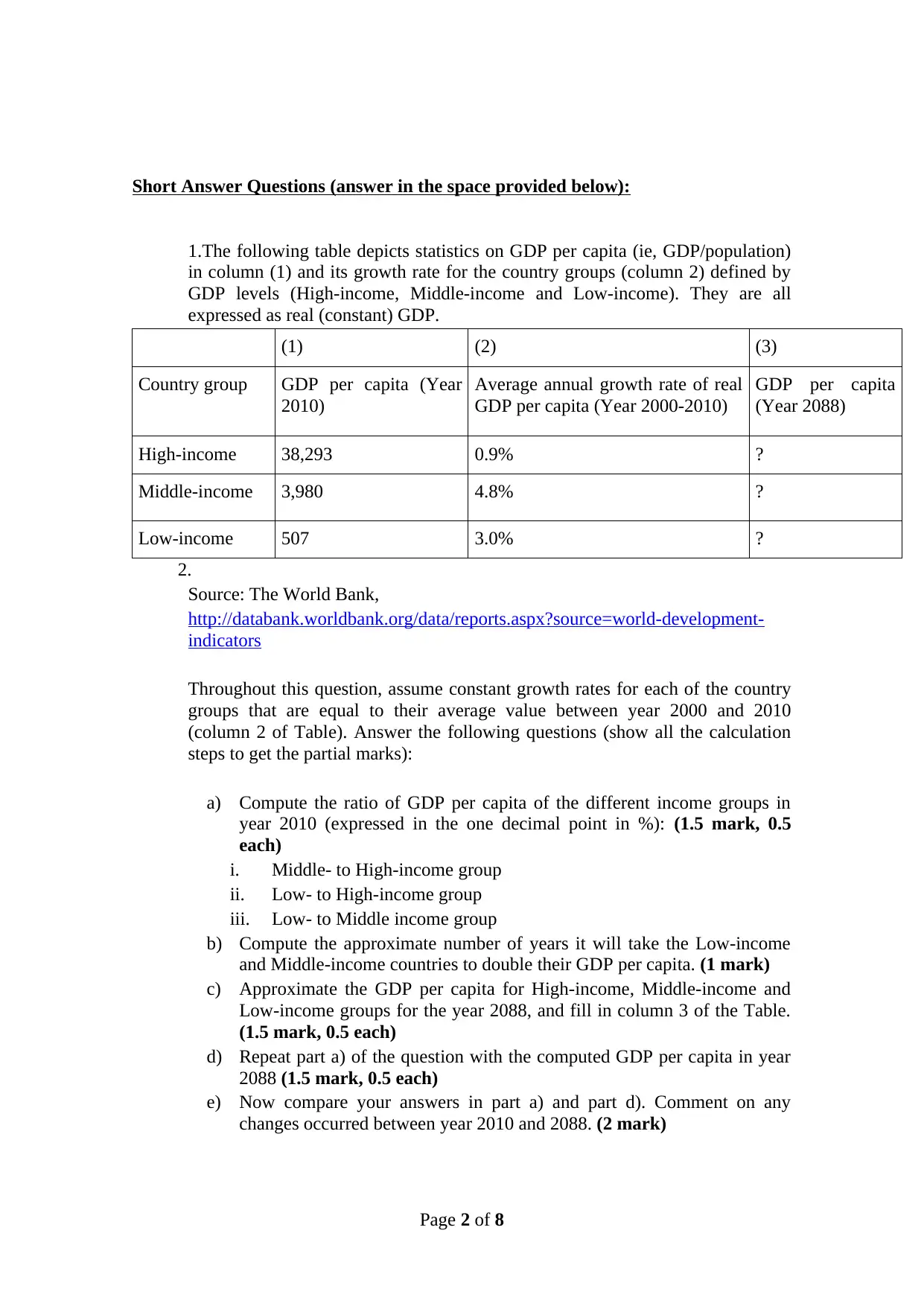
Short Answer Questions (answer in the space provided below):
1.The following table depicts statistics on GDP per capita (ie, GDP/population)
in column (1) and its growth rate for the country groups (column 2) defined by
GDP levels (High-income, Middle-income and Low-income). They are all
expressed as real (constant) GDP.
(1) (2) (3)
Country group GDP per capita (Year
2010)
Average annual growth rate of real
GDP per capita (Year 2000-2010)
GDP per capita
(Year 2088)
High-income 38,293 0.9% ?
Middle-income 3,980 4.8% ?
Low-income 507 3.0% ?
2.
Source: The World Bank,
http://databank.worldbank.org/data/reports.aspx?source=world-development-
indicators
Throughout this question, assume constant growth rates for each of the country
groups that are equal to their average value between year 2000 and 2010
(column 2 of Table). Answer the following questions (show all the calculation
steps to get the partial marks):
a) Compute the ratio of GDP per capita of the different income groups in
year 2010 (expressed in the one decimal point in %): (1.5 mark, 0.5
each)
i. Middle- to High-income group
ii. Low- to High-income group
iii. Low- to Middle income group
b) Compute the approximate number of years it will take the Low-income
and Middle-income countries to double their GDP per capita. (1 mark)
c) Approximate the GDP per capita for High-income, Middle-income and
Low-income groups for the year 2088, and fill in column 3 of the Table.
(1.5 mark, 0.5 each)
d) Repeat part a) of the question with the computed GDP per capita in year
2088 (1.5 mark, 0.5 each)
e) Now compare your answers in part a) and part d). Comment on any
changes occurred between year 2010 and 2088. (2 mark)
Page 2 of 8
1.The following table depicts statistics on GDP per capita (ie, GDP/population)
in column (1) and its growth rate for the country groups (column 2) defined by
GDP levels (High-income, Middle-income and Low-income). They are all
expressed as real (constant) GDP.
(1) (2) (3)
Country group GDP per capita (Year
2010)
Average annual growth rate of real
GDP per capita (Year 2000-2010)
GDP per capita
(Year 2088)
High-income 38,293 0.9% ?
Middle-income 3,980 4.8% ?
Low-income 507 3.0% ?
2.
Source: The World Bank,
http://databank.worldbank.org/data/reports.aspx?source=world-development-
indicators
Throughout this question, assume constant growth rates for each of the country
groups that are equal to their average value between year 2000 and 2010
(column 2 of Table). Answer the following questions (show all the calculation
steps to get the partial marks):
a) Compute the ratio of GDP per capita of the different income groups in
year 2010 (expressed in the one decimal point in %): (1.5 mark, 0.5
each)
i. Middle- to High-income group
ii. Low- to High-income group
iii. Low- to Middle income group
b) Compute the approximate number of years it will take the Low-income
and Middle-income countries to double their GDP per capita. (1 mark)
c) Approximate the GDP per capita for High-income, Middle-income and
Low-income groups for the year 2088, and fill in column 3 of the Table.
(1.5 mark, 0.5 each)
d) Repeat part a) of the question with the computed GDP per capita in year
2088 (1.5 mark, 0.5 each)
e) Now compare your answers in part a) and part d). Comment on any
changes occurred between year 2010 and 2088. (2 mark)
Page 2 of 8
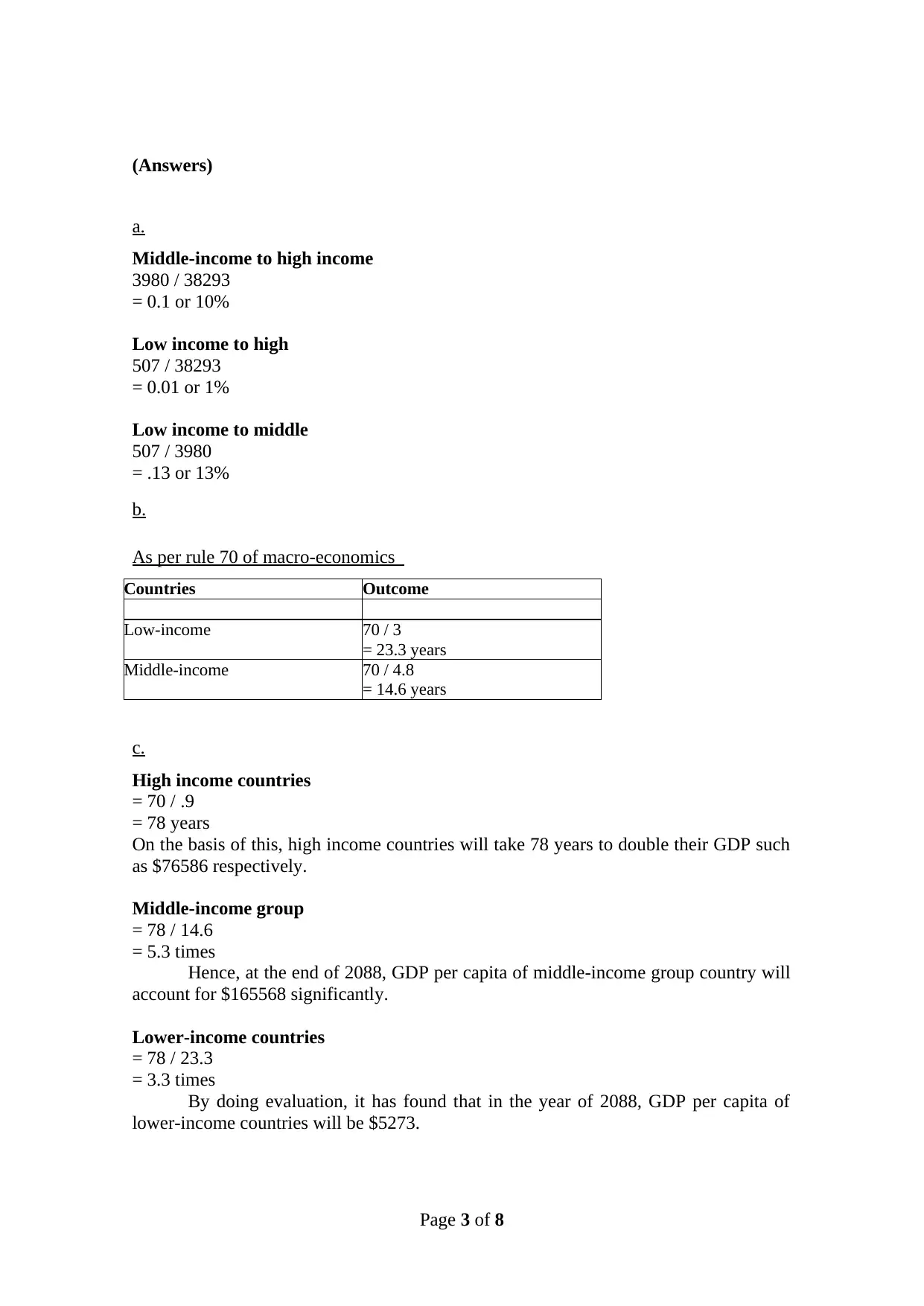
(Answers)
a.
Middle-income to high income
3980 / 38293
= 0.1 or 10%
Low income to high
507 / 38293
= 0.01 or 1%
Low income to middle
507 / 3980
= .13 or 13%
b.
As per rule 70 of macro-economics
Countries Outcome
Low-income 70 / 3
= 23.3 years
Middle-income 70 / 4.8
= 14.6 years
c.
High income countries
= 70 / .9
= 78 years
On the basis of this, high income countries will take 78 years to double their GDP such
as $76586 respectively.
Middle-income group
= 78 / 14.6
= 5.3 times
Hence, at the end of 2088, GDP per capita of middle-income group country will
account for $165568 significantly.
Lower-income countries
= 78 / 23.3
= 3.3 times
By doing evaluation, it has found that in the year of 2088, GDP per capita of
lower-income countries will be $5273.
Page 3 of 8
a.
Middle-income to high income
3980 / 38293
= 0.1 or 10%
Low income to high
507 / 38293
= 0.01 or 1%
Low income to middle
507 / 3980
= .13 or 13%
b.
As per rule 70 of macro-economics
Countries Outcome
Low-income 70 / 3
= 23.3 years
Middle-income 70 / 4.8
= 14.6 years
c.
High income countries
= 70 / .9
= 78 years
On the basis of this, high income countries will take 78 years to double their GDP such
as $76586 respectively.
Middle-income group
= 78 / 14.6
= 5.3 times
Hence, at the end of 2088, GDP per capita of middle-income group country will
account for $165568 significantly.
Lower-income countries
= 78 / 23.3
= 3.3 times
By doing evaluation, it has found that in the year of 2088, GDP per capita of
lower-income countries will be $5273.
Page 3 of 8
⊘ This is a preview!⊘
Do you want full access?
Subscribe today to unlock all pages.

Trusted by 1+ million students worldwide
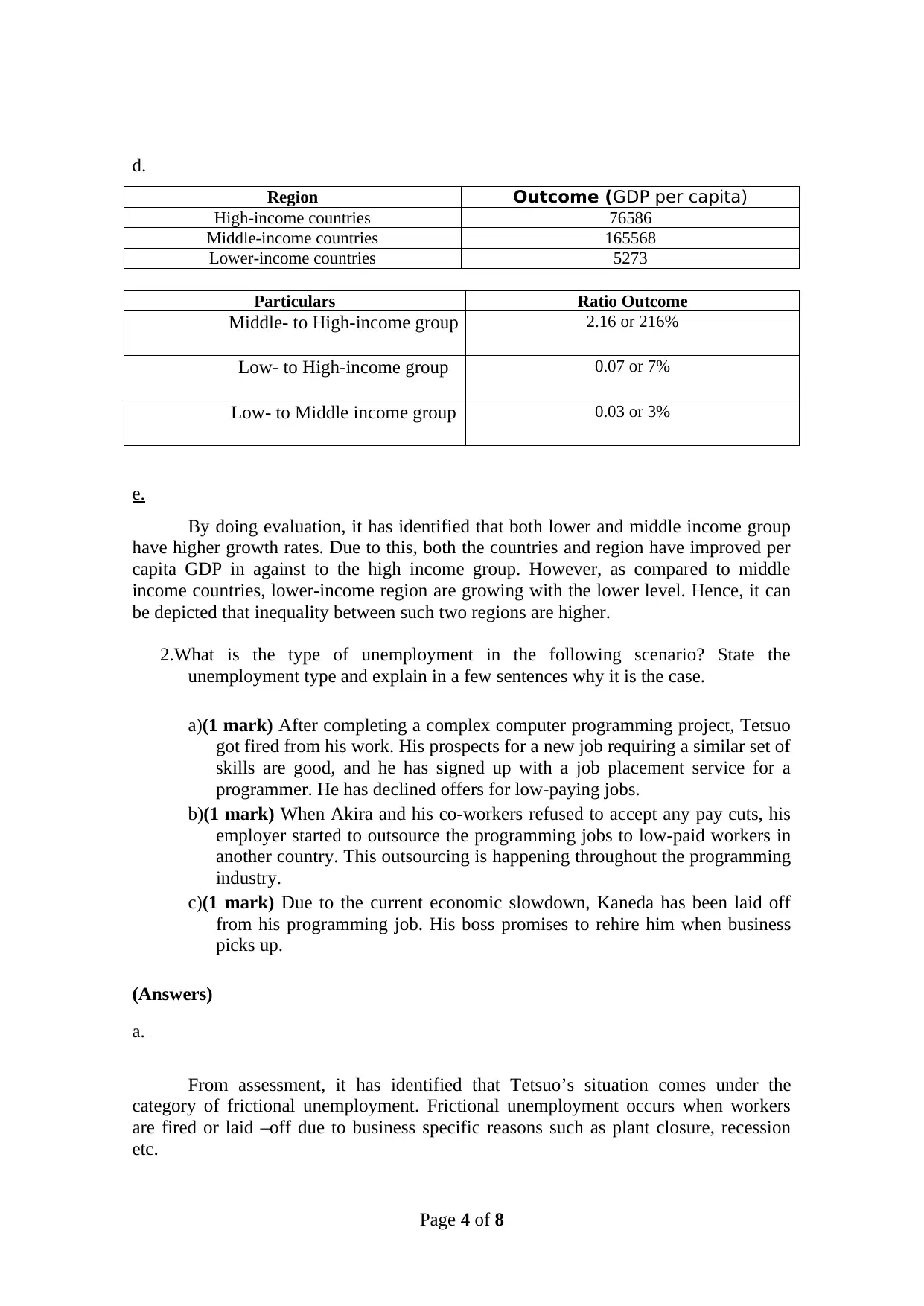
d.
Region Outcome (GDP per capita)
High-income countries 76586
Middle-income countries 165568
Lower-income countries 5273
Particulars Ratio Outcome
Middle- to High-income group 2.16 or 216%
Low- to High-income group 0.07 or 7%
Low- to Middle income group 0.03 or 3%
e.
By doing evaluation, it has identified that both lower and middle income group
have higher growth rates. Due to this, both the countries and region have improved per
capita GDP in against to the high income group. However, as compared to middle
income countries, lower-income region are growing with the lower level. Hence, it can
be depicted that inequality between such two regions are higher.
2.What is the type of unemployment in the following scenario? State the
unemployment type and explain in a few sentences why it is the case.
a)(1 mark) After completing a complex computer programming project, Tetsuo
got fired from his work. His prospects for a new job requiring a similar set of
skills are good, and he has signed up with a job placement service for a
programmer. He has declined offers for low-paying jobs.
b)(1 mark) When Akira and his co-workers refused to accept any pay cuts, his
employer started to outsource the programming jobs to low-paid workers in
another country. This outsourcing is happening throughout the programming
industry.
c)(1 mark) Due to the current economic slowdown, Kaneda has been laid off
from his programming job. His boss promises to rehire him when business
picks up.
(Answers)
a.
From assessment, it has identified that Tetsuo’s situation comes under the
category of frictional unemployment. Frictional unemployment occurs when workers
are fired or laid –off due to business specific reasons such as plant closure, recession
etc.
Page 4 of 8
Region Outcome (GDP per capita)
High-income countries 76586
Middle-income countries 165568
Lower-income countries 5273
Particulars Ratio Outcome
Middle- to High-income group 2.16 or 216%
Low- to High-income group 0.07 or 7%
Low- to Middle income group 0.03 or 3%
e.
By doing evaluation, it has identified that both lower and middle income group
have higher growth rates. Due to this, both the countries and region have improved per
capita GDP in against to the high income group. However, as compared to middle
income countries, lower-income region are growing with the lower level. Hence, it can
be depicted that inequality between such two regions are higher.
2.What is the type of unemployment in the following scenario? State the
unemployment type and explain in a few sentences why it is the case.
a)(1 mark) After completing a complex computer programming project, Tetsuo
got fired from his work. His prospects for a new job requiring a similar set of
skills are good, and he has signed up with a job placement service for a
programmer. He has declined offers for low-paying jobs.
b)(1 mark) When Akira and his co-workers refused to accept any pay cuts, his
employer started to outsource the programming jobs to low-paid workers in
another country. This outsourcing is happening throughout the programming
industry.
c)(1 mark) Due to the current economic slowdown, Kaneda has been laid off
from his programming job. His boss promises to rehire him when business
picks up.
(Answers)
a.
From assessment, it has identified that Tetsuo’s situation comes under the
category of frictional unemployment. Frictional unemployment occurs when workers
are fired or laid –off due to business specific reasons such as plant closure, recession
etc.
Page 4 of 8
Paraphrase This Document
Need a fresh take? Get an instant paraphrase of this document with our AI Paraphraser
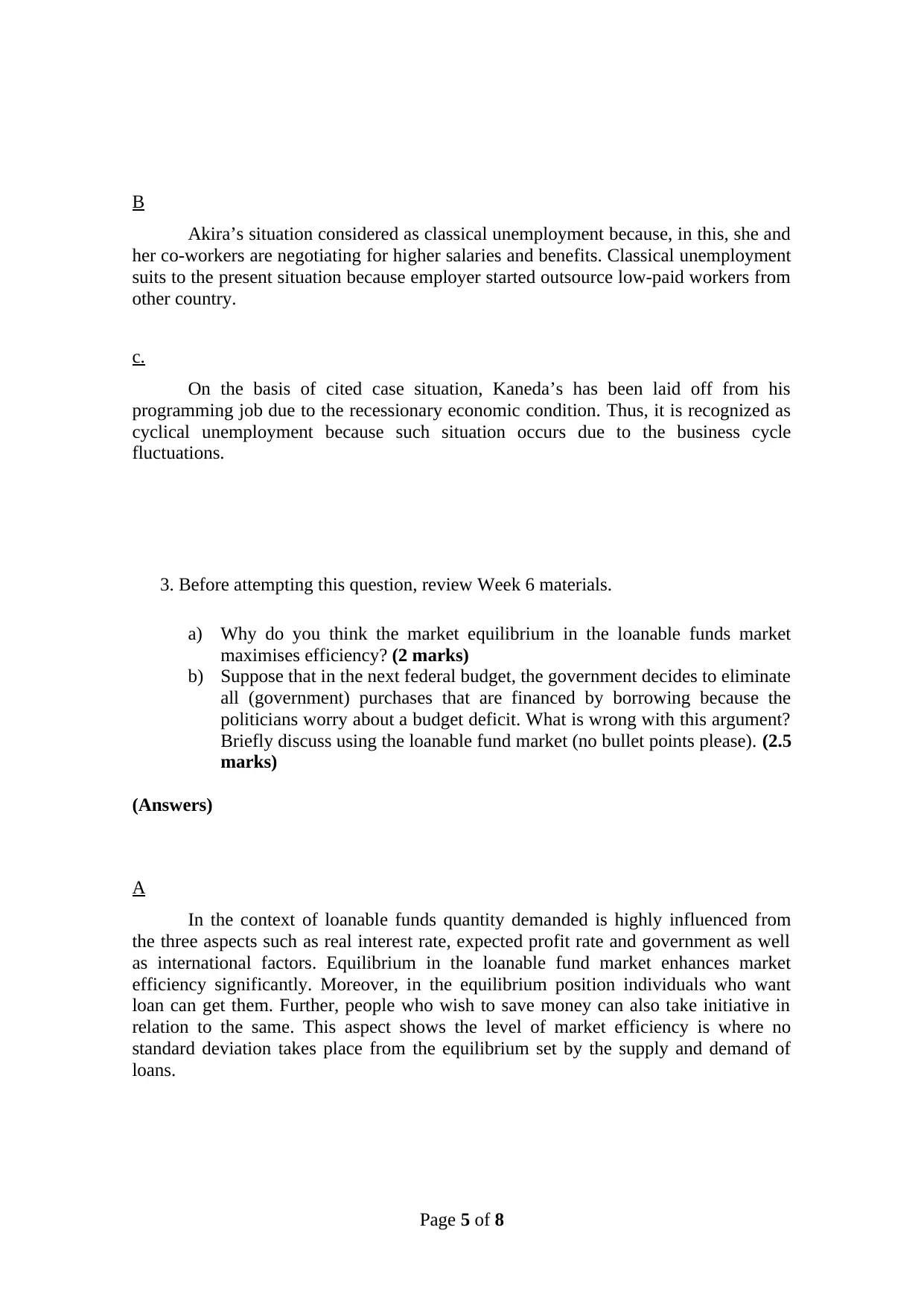
B
Akira’s situation considered as classical unemployment because, in this, she and
her co-workers are negotiating for higher salaries and benefits. Classical unemployment
suits to the present situation because employer started outsource low-paid workers from
other country.
c.
On the basis of cited case situation, Kaneda’s has been laid off from his
programming job due to the recessionary economic condition. Thus, it is recognized as
cyclical unemployment because such situation occurs due to the business cycle
fluctuations.
3. Before attempting this question, review Week 6 materials.
a) Why do you think the market equilibrium in the loanable funds market
maximises efficiency? (2 marks)
b) Suppose that in the next federal budget, the government decides to eliminate
all (government) purchases that are financed by borrowing because the
politicians worry about a budget deficit. What is wrong with this argument?
Briefly discuss using the loanable fund market (no bullet points please). (2.5
marks)
(Answers)
A
In the context of loanable funds quantity demanded is highly influenced from
the three aspects such as real interest rate, expected profit rate and government as well
as international factors. Equilibrium in the loanable fund market enhances market
efficiency significantly. Moreover, in the equilibrium position individuals who want
loan can get them. Further, people who wish to save money can also take initiative in
relation to the same. This aspect shows the level of market efficiency is where no
standard deviation takes place from the equilibrium set by the supply and demand of
loans.
Page 5 of 8
Akira’s situation considered as classical unemployment because, in this, she and
her co-workers are negotiating for higher salaries and benefits. Classical unemployment
suits to the present situation because employer started outsource low-paid workers from
other country.
c.
On the basis of cited case situation, Kaneda’s has been laid off from his
programming job due to the recessionary economic condition. Thus, it is recognized as
cyclical unemployment because such situation occurs due to the business cycle
fluctuations.
3. Before attempting this question, review Week 6 materials.
a) Why do you think the market equilibrium in the loanable funds market
maximises efficiency? (2 marks)
b) Suppose that in the next federal budget, the government decides to eliminate
all (government) purchases that are financed by borrowing because the
politicians worry about a budget deficit. What is wrong with this argument?
Briefly discuss using the loanable fund market (no bullet points please). (2.5
marks)
(Answers)
A
In the context of loanable funds quantity demanded is highly influenced from
the three aspects such as real interest rate, expected profit rate and government as well
as international factors. Equilibrium in the loanable fund market enhances market
efficiency significantly. Moreover, in the equilibrium position individuals who want
loan can get them. Further, people who wish to save money can also take initiative in
relation to the same. This aspect shows the level of market efficiency is where no
standard deviation takes place from the equilibrium set by the supply and demand of
loans.
Page 5 of 8
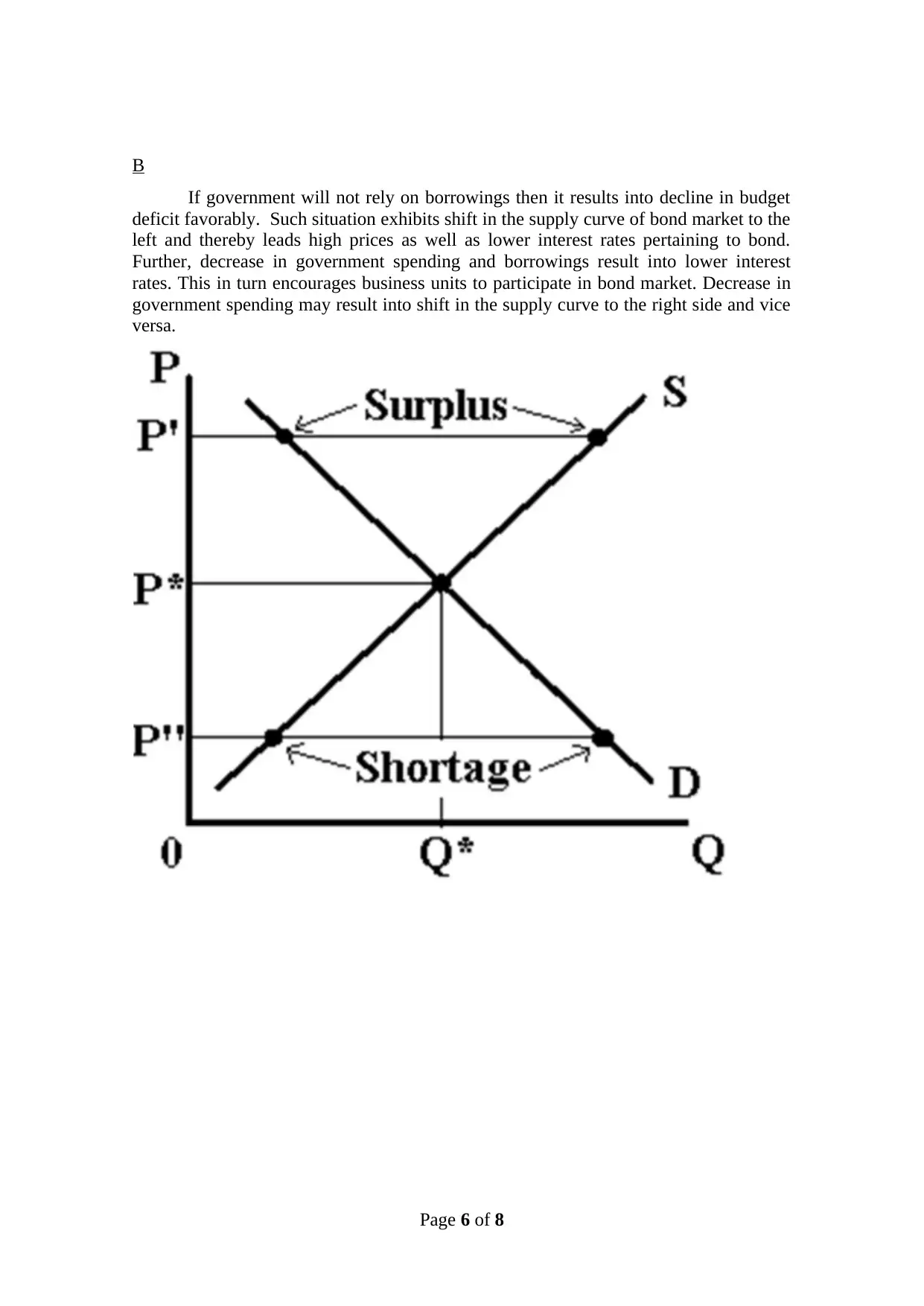
B
If government will not rely on borrowings then it results into decline in budget
deficit favorably. Such situation exhibits shift in the supply curve of bond market to the
left and thereby leads high prices as well as lower interest rates pertaining to bond.
Further, decrease in government spending and borrowings result into lower interest
rates. This in turn encourages business units to participate in bond market. Decrease in
government spending may result into shift in the supply curve to the right side and vice
versa.
Page 6 of 8
If government will not rely on borrowings then it results into decline in budget
deficit favorably. Such situation exhibits shift in the supply curve of bond market to the
left and thereby leads high prices as well as lower interest rates pertaining to bond.
Further, decrease in government spending and borrowings result into lower interest
rates. This in turn encourages business units to participate in bond market. Decrease in
government spending may result into shift in the supply curve to the right side and vice
versa.
Page 6 of 8
⊘ This is a preview!⊘
Do you want full access?
Subscribe today to unlock all pages.

Trusted by 1+ million students worldwide

4.Watch the following 10 minute video,
www.gapminder.org/videos/what-stops-population-growth
or use alternative link: https://vimeo.com/2905893
Summarise the video in minimum of 5 sentences (Not in bullet points, please!).
Also, what were the most interesting or surprising facts you learned from this
video? (5 marks).
(Answers)
By seeing this video, it has assessed that the only way to stop population growth
is to have smaller families. Video presented surprising fact that at the end of 2055,
world’s population will be approximately 9 billion’s. In the year of 2008, world’s
population inclined from 3 to 6.7 billion. Further, it entails that high population growth
destroys the environment to a great extent which in turn recognized as a major concern.
In addition to this, as compared to developed countries, after the period of 1950
population of India and China is growing significantly. Thus, for reducing the level of
population growth and protecting environment as well as poor child emphasis need to
be placed on making smaller families.
Page 7 of 8
www.gapminder.org/videos/what-stops-population-growth
or use alternative link: https://vimeo.com/2905893
Summarise the video in minimum of 5 sentences (Not in bullet points, please!).
Also, what were the most interesting or surprising facts you learned from this
video? (5 marks).
(Answers)
By seeing this video, it has assessed that the only way to stop population growth
is to have smaller families. Video presented surprising fact that at the end of 2055,
world’s population will be approximately 9 billion’s. In the year of 2008, world’s
population inclined from 3 to 6.7 billion. Further, it entails that high population growth
destroys the environment to a great extent which in turn recognized as a major concern.
In addition to this, as compared to developed countries, after the period of 1950
population of India and China is growing significantly. Thus, for reducing the level of
population growth and protecting environment as well as poor child emphasis need to
be placed on making smaller families.
Page 7 of 8
Paraphrase This Document
Need a fresh take? Get an instant paraphrase of this document with our AI Paraphraser

Page 8 of 8
1 out of 8
Your All-in-One AI-Powered Toolkit for Academic Success.
+13062052269
info@desklib.com
Available 24*7 on WhatsApp / Email
![[object Object]](/_next/static/media/star-bottom.7253800d.svg)
Unlock your academic potential
Copyright © 2020–2025 A2Z Services. All Rights Reserved. Developed and managed by ZUCOL.